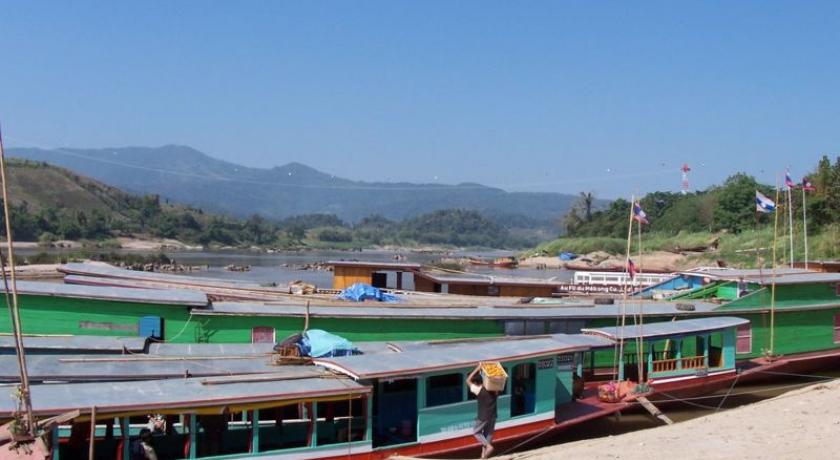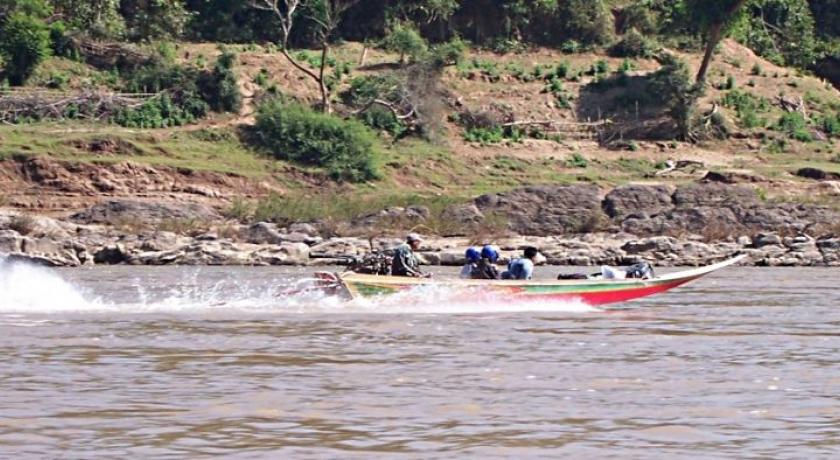Description
Houay Xai (also Huay xai, Houei Sai, etc) is the capital of the Laos province of Bokeo. It lies on the banks of the Mekong River, which forms the border to Thailand.
Understand
For most tourists it is seen as a transport stop-over, which is quite a pity. While there is not much to see in this small town, it's a good place to adapt to the Lao lifestyle: sit on the banks of the Mekong, have a Beer Lao and watch the river flow past.
Get in
Immigration: The Lao immigration office is located 10 km south of town, and issues 30-day Visas-on-Arrival (around 35 USD, depending on nationality, or 1,500 baht. The cost in Euros tends to be the same as the dollar cost, with Lao authorities ignoring exchange rate differentials). A passport-sized photo is needed and this can be obtained in Chiang Khong Thailand, before crossing the bridge in Chiang Khong or earlier near the bus station in Chiang Rai. If you arrive without a passport photo, the official will use a scan of your passport photo for 40 baht. If you arrive on a weekend there is an extra $1 "weekend-fee" for the visa on arrival. During weekdays after 16.00 pm there is also extra charge of $1, called "overtime fee". It also applies for nationals who don’t need lao visa. "Overtime/weekend fee" seems to be official now, with a printed notice on the counter referring to it. It’s often possible to avoid this fee by arguing with the officials or just walking out fast once you get your stamp, but at the end of the day it's only $1.
Crossing the border Lao/Thailand
Since December 2013, crossing the border is done via the new friendship bridge 4. The Lao border control is located 10 km south of town; tuk-tuk are available. You must take a bus (25B/pax, 40B in weekend and after 4pm) to cross the bridge from the Thai border control to the Lao border control and vice versa. If you are travelling by bicycle please note it is not allowed to cycle over the friendship bridge. You also have to take a bus, transporting your bike on the bus costs 100B per bike. The price is fixed, but it might be possible that you only pay for the transport of your bicycle without having to pay extra for your own ticket- (so it will be 100 B instead of 125B per person + bicycle). The bicycle will be transported inside the bus. The Thai border control is located 9 km south of Chiang Khong, tuk-tuk also available.
Tuk-tuk from Lao border control to the Huay Xai bus station/city center should be 10 000 kip but they will try to ask you for 25 000 kip. Walking out of the immigration complex and hitching passing tuk-tuk would return price to normal 10Kkip, but be careful, outside of high season you may be hard-pressed to find another tuk-tuk for miles.
By car
You can drive from Vientiane on the haunting road. If you want to touch how "haunting" it is, you have to drive at night. There will be no buildings and lights, and sometimes with the tall trees on the side (scary when you drive at night).
By plane
Houay Xai's tiny airport has service three times a week to/from Vientiane on Tuesdays, Thursdays and Saturdays. Until November 2010 there was one flight a week to Luang Prabang on Saturdays, but none in the other direction. There is talk that this flight will resume.
By bus
There are two bus stations. Keo Champa is somewhat more that 5 km south of the tourist strip. Pet Aloun is maybe 6km south, with another 5km or so further south to the border. A full list of bus times from each station can be seen on the front door of the tourist office in town.
The 9:00am bus from Luang Namtha arrives at the Keo Champa bus station (5 km from the border) at around 1:00pm. Likewise the 12:30pm bus gets in about 4:00pm. Tuk-tuks charge 10,000 kip to the border or guest house of your choice in town. (note - September 2015 Tuk-tuks charge whatever they think they can get away with. Walking to the border is a sweaty option. Most tourists seem happy to pay whatever.)
Upon arriving in Houay Xai, you might be approached by touts asking about your next destination. If you answer Luang Prabang, you will be pressured to reserve a ticket on a VIP bus, because the bus is invariably "sold out". The ticket price will be inflated to around 210,000-260,000 kip, which includes transport to the bus station. Upon arriving at the bus station, you will be handed a ticket with the actual price, 110,000 kip, staring back at you as a stinging reminder of your gullibility. At the bus station you can get a ticket all the way to Vientiane for 210,000 kip, which should give some indication of how much of a rip-off the touts in town are trying to pull on you.
If you're going to be in Houay Xai for at least a day, simply take a tuk-tuk to the bus station for 10,000 kip and buy your ticket for the day you plan to leave. The extra money you spend on tuk-tuks is more than offset by the 100,000-150,000 you'll save on your bus ticket.
From Chiang Rai, take one of the hourly bus from the provincial bus station in town (65B; 2h30; start at 6am), ask to be dropped at the intersection with the road to the friendship bridge, 4km before Chiang Khong, where some tuk-tuk will wait to bring you to the Thai border control (50B/pax; 5 km)
There is a daily sleeper bus Houay Xai to Kunming for 320 yuan, leaving around 9-10 am (Jan 2013) It is not operating for few days during Chinese New Year. It is fast, comfortable and cheap way to get to Kunming.
By ferry
Ferries crossings between Chiang Khong, Thailand and Houay Xai are no longer available. Crossing occurs via the bridge instead.
By slow boat
The slow boat is mainly used to leave Houay Xai as the journey moving upstream is usually just too long for most people. See GET OUT, below, for details. The pier is 1 km north of town, where the truck-carrying ferry barges also dock.
By speedboat
Read the warning about speedboats first. The speedboat landing is some 5 km south of town.
By bus
- The 9:30AM bus from Luang Namtha arrives at the bus station about 2 km out of town at around 2:30PM. The tuk-tuks cost 10,000 kip to the border or any guesthouse in the town. Local tickets can be bought online via Pombai.
Get around
You can walk the main street. For longer distances take a song thiaw - which is called a tuk-tuk here. A one-way fare to the Chinese morning market should cost 10,000 kip.
See
See sunset over the Mekong River from a riverside restaurant. See the view from the temple tower at the top of the hill on the main street, near the border crossing.
Do
- Pay a visit to the market. This is commonly known locally as the Morning Market and the best time to visit is early morning. The market is in the suburb of Ban Muangkeo. To get there; follow the main road south along the Mekong. After passing a hill, there is a turn-off to the left, which you should follow until you reach the place. Ask people for directions to make sure you don't take the wrong turning.
- Fort Carnot. On top of one of the hills in the center of the town is the ruins of the French colonial-era Fort Carnot. One of the towers can be climbed up for a good view around. (note: September 2015 the fort is re-opening after being closed, locked and overgrown). You can continue along the road down the other side of the hill to the Muang Keo market above.
- On main street, there is the office of The Gibbon Experience. This is a forest conservation project that raises its funds through taking guests into the Bokeo Nature Reserve. Every other day there is a truck covering the 3.5 hours to the last village, where you start your hike to the project. Accommodation is provided in terrific tree houses which are constructed on giant trees over 40 m high. To access the houses, you glide on a cable from the surrounding hill range. There is an extensive cable network being set up to explore the canopy, providing breathtaking views of the scenery and probably due to its increasing popularity prices have recently increased.
- Also on the main road, is the office of New Challenge Discovery . A team of young Lao people organizing day trips in Bokeo Province (kayak, trekking, cycling, etc.). All the funds raised are used to help and support the children in Huay Xai countryside, providing opportunities to study English. Future plans include forest protection and education. If you come for the Gibbon Experience, then spend one day more with New Challenge Discovery.
- Visit Daauw Village, located right at the city center next to the Temple. Getting off the beaten track, doing something original, leaving something behind for the local Lao people, at Daauw Village you also easily adapt to the traditional way of Lao Life and will get a deeper understanding of the Lao Culture by being part of their welcoming community. At Daauw you can join the locals around the campfire and have traditional foods in the evenings, teach English in the afternoons or join one of the many local workshops this place offers to the Lao people in the mountains. There is a Restaurant and Lounge Cafe, called Daauw Home. You can choose to do Daauw Volunteering and Daauw Trips to the villages where you will join the Team doing Creative Workshops. There is also a Woman Empowerment Shop and Workplace. If you want to have a unique experience and want to avoid the typical tourist trek, you should not skip visiting Daauw Village, owned and run by the poorest people of this area in the mountains. All profits of their activities go straight to the Lao people of the mountains.
- Visit sauna, which belongs to "Red Cross" and has quite a low ticket price (something like 2 or 3$). Massage service is provided in the sauna building (not expensive) and herbal teas. To find the sauna walk by the main road (along the river) from the village center (Lao-Thai ferry and Wat Chomkao Manilat) to the North and after crossing a bridge over a stream look at the left. Coordinates must be 20.2815, 100.4095. Don't be confused with the "Red Cross" itself, located at a different place.
Source http://wikitravel.org/en/Houay_Xai
Photograph by Bill Bradley. Billbeee 06:57, 10 May 2007 (EDT)
Address
Houay Xai
Laos
Lat: 20.262817383 - Lng: 100.434036255






